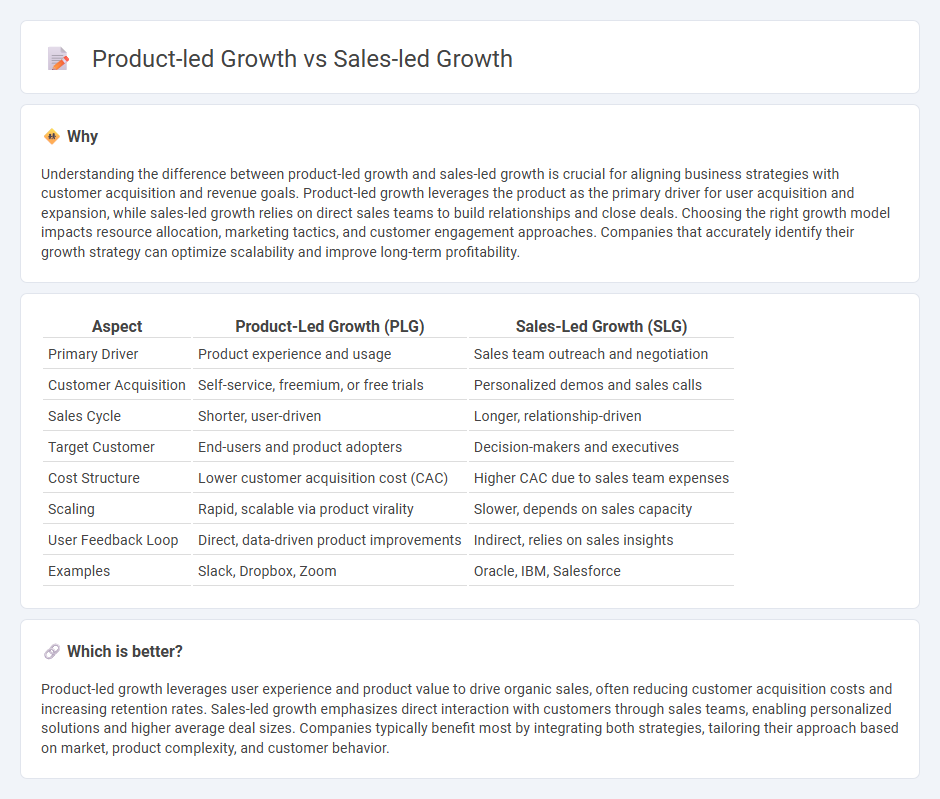
Product-led growth leverages the product itself as the primary driver for customer acquisition, engagement, and retention, often focusing on user experience and self-service models. Sales-led growth emphasizes a direct, proactive sales approach with personalized interactions to close deals and build client relationships. Explore the key differences and benefits of each strategy to determine the best fit for your business growth.
Why it is important
Understanding the difference between product-led growth and sales-led growth is crucial for aligning business strategies with customer acquisition and revenue goals. Product-led growth leverages the product as the primary driver for user acquisition and expansion, while sales-led growth relies on direct sales teams to build relationships and close deals. Choosing the right growth model impacts resource allocation, marketing tactics, and customer engagement approaches. Companies that accurately identify their growth strategy can optimize scalability and improve long-term profitability.
Comparison Table
| Aspect | Product-Led Growth (PLG) | Sales-Led Growth (SLG) |
|---|---|---|
| Primary Driver | Product experience and usage | Sales team outreach and negotiation |
| Customer Acquisition | Self-service, freemium, or free trials | Personalized demos and sales calls |
| Sales Cycle | Shorter, user-driven | Longer, relationship-driven |
| Target Customer | End-users and product adopters | Decision-makers and executives |
| Cost Structure | Lower customer acquisition cost (CAC) | Higher CAC due to sales team expenses |
| Scaling | Rapid, scalable via product virality | Slower, depends on sales capacity |
| User Feedback Loop | Direct, data-driven product improvements | Indirect, relies on sales insights |
| Examples | Slack, Dropbox, Zoom | Oracle, IBM, Salesforce |
Which is better?
Product-led growth leverages user experience and product value to drive organic sales, often reducing customer acquisition costs and increasing retention rates. Sales-led growth emphasizes direct interaction with customers through sales teams, enabling personalized solutions and higher average deal sizes. Companies typically benefit most by integrating both strategies, tailoring their approach based on market, product complexity, and customer behavior.
Connection
Product-led growth leverages user experience and product adoption to drive revenue, while sales-led growth relies on direct interaction and relationship-building to close deals. Both strategies intersect as product-led insights inform targeted sales outreach, enhancing conversion rates and customer retention. Integrating product analytics with sales intelligence creates a seamless pipeline that accelerates pipeline velocity and maximizes customer lifetime value.
Key Terms
Sales Funnel
Sales-led growth emphasizes optimizing the sales funnel by targeting high-intent leads and nurturing prospects through personalized outreach and demos, accelerating conversion rates at each funnel stage. Product-led growth prioritizes a frictionless user experience within the product itself, leveraging free trials, self-service onboarding, and in-app engagement to drive user acquisition and activation organically. Explore the nuances of both growth strategies to refine your sales funnel efficiency and maximize revenue impact.
Product Adoption
Sales-led growth prioritizes direct customer engagement through targeted sales efforts to drive revenue, often relying on personalized outreach and relationship building to accelerate product adoption. Product-led growth emphasizes a seamless user experience and self-service models that enable customers to discover and adopt the product independently, leveraging features such as free trials, onboarding flows, and in-app guidance. Explore detailed strategies to optimize product adoption in both sales-led and product-led growth models.
Customer Acquisition Cost
Sales-led growth strategies often result in higher Customer Acquisition Costs (CAC) due to expenses related to sales team salaries, commissions, and extensive outreach efforts. Product-led growth minimizes CAC by leveraging the product itself as the primary tool for acquiring and retaining users through free trials, freemium models, and self-service onboarding. Explore our detailed analysis to understand which growth model optimizes your acquisition budget effectively.
Source and External Links
What Is Sales-Led Growth? - Cello.so - Sales-led growth is a business strategy that prioritizes sales teams and sales activities at the core of driving revenue and overall business growth, focusing on customer acquisition, retention, and data-driven decision-making to maximize profitability and market competitiveness.
What is Sales-Led Growth? [+ Examples to Inspire You] - Operatus - Sales-led growth is a strategy where sales reps actively move leads through the sales funnel and influence marketing and product strategies by leveraging close customer relationships, with a focus on driving revenue growth and maximizing customer lifetime value (CLV).
Product-led growth vs. sales-led growth: Key differences explained - Sales-led growth relies heavily on a hands-on sales team to manage complex or high-touch sales processes, focusing on personal interaction and negotiation for customer acquisition and retention, which contrasts with product-led growth that emphasizes product experience for rapid user adoption.
 dowidth.com
dowidth.com